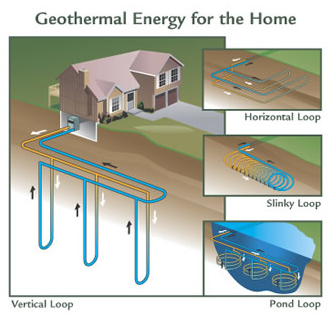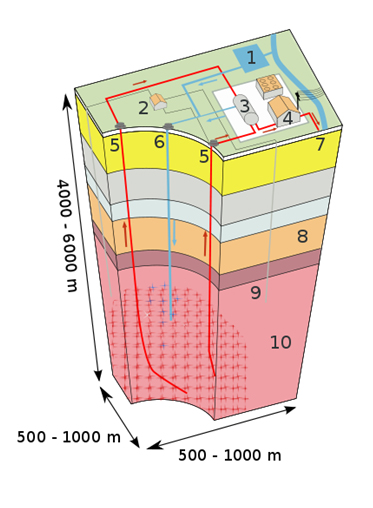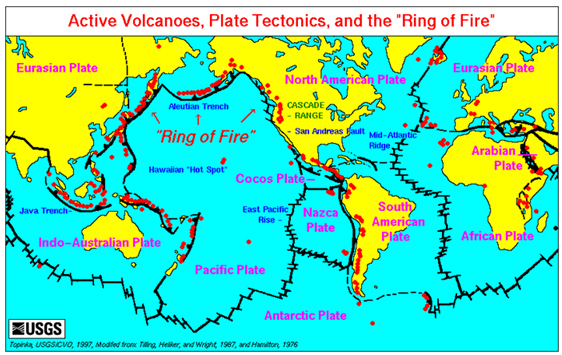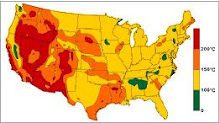
Geothermal Energy
Geothermal energy is the heat from the Earth. It's clean and sustainable. Resources of geothermal energy range from the shallow ground to hot water and hot rock found a few miles beneath the Earth's surface, and down even deeper to the extremely high temperatures of molten rock called magma.
Geothermal Heat-pump:
Almost everywhere, the shallow ground or upper 10 feet of the Earth's surface maintains a nearly constant temperature between 50° and 60°F (10° and 16°C).
Geothermal heat pumps can tap into this resource to heat and cool buildings. A geothermal heat pump system consists of a heat pump, an air delivery system (ductwork), and a heat exchanger-a system of pipes buried in the shallow ground near the building. For more info click here to see: HVAC.
Because heat pumps need power, systems exist that include solar panels to provide the electricity. Such systems allow for complete control of a home’s temperature conditions while being completely independent from third party energy providers.
Dig deeper.
Below the Earth's crust is a layer of hot and molten rock called magma where heat is continually produced mostly from the decay of naturally radioactive materials such as uranium and potassium.
The amount of heat within 10,000 meters (about 33,000 feet) of Earth's surface contains 50,000 times more energy than all the oil and natural gas resources combined.
In addition, there is a vast amount of heat energy available from dry rock formations very deep below the surface (4–10 km). Using a set of emerging technologies known as Enhanced Geothermal Systems (EGS), we may be able to capture this heat for electricity production on a much larger scale than conventional technologies allow.
No fuel is used to generate the power, which means the running costs for the plants are very low as there are no costs for purchasing, transporting, or cleaning up of fuels.
The cost to build a geothermal power plant is cheaper than if you were planning to construct another power sources such as an; oil, gas, coal, or nuclear power plant. Since the geothermal plants take up very little room, no purchase of a larger area of land is needed.
Not only do geothermal resources in the United States offer great potential, they can also provide continuous baseload electricity. According to the U.S. National Renewable Energy Laboratory, the capacity factors of geothermal plants—a measure of the ratio of the actual electricity generated over time compared to what would be produced if the plant was running nonstop for that period—are comparable with those of coal and nuclear power. With the combination of both the size of the resource base and its consistency, geothermal can play an indispensable role in a cleaner, more sustainable power system.
Where available
In the United States, most geothermal reservoirs of hot water are located in the western states, Alaska, and Hawaii. Some geothermal power plants use the steam from a reservoir to power a turbine/generator, while others use the hot water to boil a working fluid that vaporizes and then turns a turbine. Hot water near the surface of Earth can be used directly for heat. Direct-use applications include heating buildings, growing plants in greenhouses, drying crops, heating water at fish farms, and several industrial processes such as pasteurizing milk.
U.S. geothermal potential. Source: NREL
Areas with the highest underground temperatures are in regions with active or geologically young volcanoes. These "hot spots" occur at plate boundaries or at places where the crust is thin enough to let the heat through. The Pacific Rim, often called the Ring of Fire for its many volcanoes, has many hot spots, including some in Alaska, California, and Oregon. Nevada has hundreds of hot spots, covering much of the northern part of the state.
If these resources can be tapped, they offer enormous potential for electricity production capacity. In its first comprehensive assessment in more than 30 years, the U.S. Geological Survey (USGS) estimated that conventional geothermal sources on private and accessible public lands across 13 western states have the potential capacity to produce 8,000–73,000 MW, with a mean estimate of 33,000 MW. State and federal policies are likely to spur developers to tap some of this potential in the next few years. The Geothermal Energy Association estimates that 132 projects now under development around the country could provide up to 6,400 megawatts of new capacity. As EGS technologies improve and become competitive, even more of the largely untapped geothermal resource could be developed. The USGS study found that hot dry rock resources could provide another 345,100–727,900 MW of capacity, with a mean estimate of 517,800 MW. That means that this resource could one day supply nearly all of today’s U.S. electricity needs.




The Future of Geothermal Energy
Geothermal energy has the potential to play a significant role in moving the United States (and other regions of the world) toward a cleaner, more sustainable energy system. It is one of the few renewable energy technologies that—like fossil fuels—can supply continuous, baseload power. The costs for electricity from geothermal facilities are also declining. Some geothermal facilities have realized at least 50 percent reductions in the price of electricity since 1980. A considerable portion of potential geothermal resources will be able produce electricity for as little as 8 cents per kilowatt-hour (including a production tax credit), a cost level competitive with new conventional fossil fuel-fired power plants. There is also a bright future for the direct use of geothermal resources as a heating source for homes and businesses in any location. However, in order to tap into the full potential of geothermal energy, two emerging technologies require further development: Enhanced Geothermal Systems (EGS) and co-production of geothermal electricity in oil and gas wells.
The Department of Energy, several universities, the geothermal industry, and venture capital firms (including Google) are collaborating on research and demonstration projects to harness the potential of hot dry rock. Australia, France, Germany, and Japan also have R&D programs to make EGS commercially viable. The DOE hopes to have EGS ready for commercial development by 2015 and is currently funding several demonstration projects.
An earlier effort in Basel, Switzerland was shut down after it triggered earthquakes. As mentioned above, drilling for geothermal projects can cause earthquakes and several have been abandoned because of this.
Also in the process of creating geothermal plants, drilling poses the greatest problem. The companies best equipped to take advantage of geothermal energy are the existing oil and gas companies because of their advanced drilling technologies. However, ironically, these same companies have the least financial interest in doing so because it would directly compete with their existing business models (see articles below).
According to EERE:
One cause for careful consideration with EGS is the possibility of induced seismic activity that might occur from hot dry rock drilling and development. This risk is similar to that associated with hydraulic facturing, an increasingly used method of oil and gas drilling, and with carbon dioxide capture and storage in deep saline aquifers. Though a potentially serious concern, the risk of an induced EGS-related seismic event that can be felt by the surrounding population or that might cause significant damage currently appears very low when projects are located an appropriate distance away from major fault lines and properly monitored. Appropriate site selection, assessment and monitoring of rock fracturing and seismic activity during and after construction, and open and transparent communication with local communities are also critical.
Information was obtained from the following websites- for more in depth information view:
Zurich project abandoned due to earthquake development:
http://www.popsci.com/technology/article/2009-12/two-major-geothermal-projects-terminated-amid-quake-risk-questions
The energy Groove:
http://www.energygroove.net/geothermalenergy.php
http://m.ucsusa.org/clean_energy/our-energy-choices/renewable-energy/how-geothermal-energy-works.html
Geothermal power in Iceland: http://en.wikipedia.org/wiki/Geothermal_power_in_Iceland
Iceland Adventure : http://iceland.ednet.ns.ca/schedule.htm#